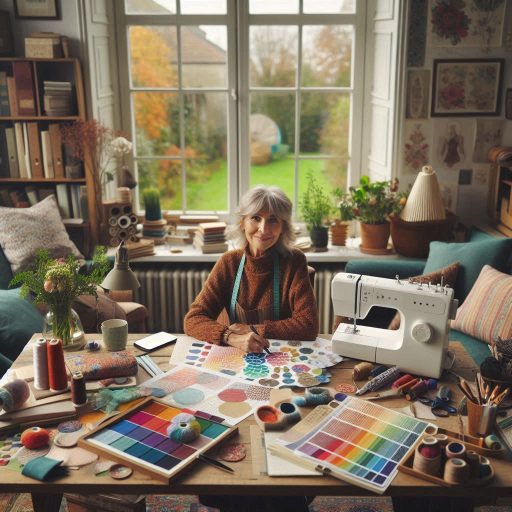Introduction
Balancing art and commerce in textile design is essential for achieving success in the industry.
Designers must effectively blend creativity with market demands to thrive.
This balance not only fosters innovation but also ensures profitability, allowing brands to grow and adapt.
Artistic expression drives the creation of unique designs that attract customers and set trends.
Each textile tells a story, showcasing the designer‘s vision and craftsmanship.
However, without financial viability, even the most stunning textiles can fail to reach their potential in the marketplace.
A beautiful design that doesn‘t resonate with consumer needs may struggle to sell, making financial insight vital.
Finding this equilibrium is crucial for enhancing brand reputation and ensuring longevity.
Designers who embrace both creativity and commerce can meet diverse consumer expectations while pushing artistic boundaries.
They can create textiles that captivate the market, allowing for exploration of new materials and techniques.
This dual approach creates a sustainable business model where creativity thrives alongside profitability.
By prioritizing both art and commerce, designers can inspire others and elevate the textile industry.
The Role of Creativity in Textile Design
Significance of creativity in creating unique and innovative textile designs
Creativity is essential for creating unique textile designs.
It allows designers to:
- Develop Original Concepts: Innovative ideas lead to fresh patterns and textures.
Originality captures attention and interest. - Solve Problems: Creative thinking helps designers overcome challenges.
It enables them to find effective solutions that enhance functionality and aesthetics. - Adapt Trends: Designers can incorporate current trends while adding their personal touch.
This adaptability keeps their work relevant and engaging.
How artistic expression can set a designer apart in a competitive market
Artistic expression distinguishes one designer from another.
This uniqueness is vital for standing out in a saturated market.
Designers can benefit from artistic expression in several ways:
- Building a Signature Style: A recognizable style attracts loyal customers.
It creates a personal brand that resonates with consumers. - Emotional Connection: Art has the power to evoke emotions.
Designs that reflect a designer’s passion can create strong connections with the audience. - Storytelling: Every design can tell a story.
Designers can convey their inspirations and ideas through their work, enriching the viewer’s experience.
Competitive Edge
In a crowded textile market, creativity offers a competitive edge.
Designers who embrace creativity can:
- Differentiate Themselves: Unique designs stand out in stores and online.
This differentiation draws in customers looking for something special. - Create Market Demand: Innovative designs can set new trends.
When consumers see something fresh, they often want to buy it. - Foster Collaboration: Creative designers attract collaboration opportunities.
Brands and manufacturers often seek unique talents to enhance their offerings.
The Fusion of Art and Commerce
Balancing creativity with commercial viability is crucial.
Designers must ensure their artistic vision aligns with market demands.
To achieve this balance, they can:
- Research Market Trends: Understanding consumer preferences guides creative decisions.
This research informs designers about what styles and colors are popular. - Experiment with Materials: Exploring various materials can inspire new designs.
This experimentation often leads to unexpected and exciting results. - Seek Feedback: Designers should actively seek feedback on their work.
Constructive criticism helps refine designs and enhances creativity.
In textile design, creativity is paramount.
It fuels innovation, builds personal brands, and sets designers apart in a competitive landscape.
By embracing creativity, designers can create unique, marketable products that resonate with consumers.
Balancing art and commerce ultimately leads to success in the textile industry.
Read: Top Skills Needed for Art Educators and Instructors
Understanding the Market Trends
Staying updated on current market trends is essential for textile designers.
Awareness of trends helps designers make informed decisions about their work.
Here‘s why understanding market trends matters:
Importance of staying updated on current market trends in textile design
- Consumer Preferences: Trends reveal what consumers want.
This insight allows designers to create products that resonate with their audience. - Competitive Advantage: Knowledge of trends provides a competitive edge.
Designers can stand out by incorporating popular elements into their designs. - Informed Decisions: Market trends guide material selection, color palettes, and patterns.
Designers can align their creations with current styles. - Business Growth: Adapting to trends can lead to increased sales.
Designers who understand market demands can boost their brand visibility.
How market research can help designers cater to consumer preferences while maintaining artistic integrity
Conducting market research is vital for successful textile design.
It helps designers understand the landscape and consumer needs.
Here‘s how market research benefits designers:
- Identifying Trends: Research helps designers spot emerging trends early.
They can innovate and adapt before trends peak. - Analyzing Competition: Understanding competitors‘ offerings allows designers to differentiate their work.
This knowledge informs unique design strategies. - Gathering Consumer Feedback: Engaging with consumers provides valuable insights.
Designers can learn what features appeal to their target market. - Tailoring Designs: Market research enables designers to cater to specific demographics.
They can create textiles that meet the tastes of various consumer groups.
Balancing Art and Commerce
Designers often face the challenge of balancing artistic vision with commercial demands.
Here are some strategies to maintain this balance:
- Stay True to Your Style: Retain your unique artistic voice.
Infuse trends into your work without compromising your creative identity. - Experiment with Trends: Use trends as inspiration rather than a blueprint.
This approach allows for innovative designs that remain relevant. - Collaborate with Industry Experts: Partner with marketers or business professionals.
They can provide insights on market demands while respecting artistic integrity. - Evaluate Your Audience: Understand your target demographic.
Tailor your designs based on their preferences while preserving your artistic vision.
In textile design, understanding market trends is crucial.
Designers must balance their artistic integrity with commercial viability.
Market research plays a significant role in this process.
By staying updated on trends, designers can create textiles that resonate with consumers while remaining true to their vision.
Embrace the challenge of merging art with commerce to achieve lasting success in the textile industry.
Read: Collaborating with Other Creative Roles
Collaborating with Manufacturers and Suppliers
Benefits of collaborating with manufacturers and suppliers in the textile industry
Collaborating with manufacturers and suppliers in the textile industry offers numerous advantages.
This partnership enhances communication, ensuring everyone is on the same page.
By aligning goals, designers and manufacturers can achieve a shared vision.
Effective collaboration leads to streamlined production processes.
When designers work closely with manufacturers, they can discuss materials and techniques early.
This proactive approach minimizes misunderstandings and reduces delays.
A shared understanding of timelines fosters efficient workflows.
Manufacturers bring valuable insights into production capabilities.
They can suggest practical adjustments to designs that maintain artistic integrity.
This input allows designers to optimize their creations for manufacturability without sacrificing quality.
Suppliers also play a crucial role in this collaboration.
They offer access to innovative materials and technologies.
By building strong relationships with suppliers, designers can explore unique fabrics that elevate their collections.
This access can differentiate a designer’s work in a competitive market.
How working collaboratively can help streamline production processes and improve profitability
Moreover, collaboration can lead to cost savings.
Working together often uncovers opportunities to reduce production costs.
Designers can negotiate better prices on materials by purchasing in bulk with manufacturers.
This strategy improves profit margins and allows for competitive pricing.
Another benefit is the opportunity for rapid prototyping.
When designers collaborate with manufacturers, they can quickly create samples.
This quick turnaround helps designers test and refine their ideas more effectively.
Feedback from manufacturers can guide adjustments, ensuring the final product meets market needs.
Building strong relationships fosters trust and transparency.
A trustworthy partnership allows for open discussions about challenges and opportunities.
This environment encourages innovation, as both parties feel comfortable sharing ideas.
Trust also leads to better problem-solving when issues arise during production.
Furthermore, collaboration can enhance sustainability efforts.
By working together, designers and manufacturers can identify eco-friendly materials and processes.
This commitment to sustainability can attract consumers who prioritize ethical practices.
Additionally, leveraging each partner’s expertise can enhance product quality.
Manufacturers often have experience with various production techniques.
Their knowledge can help designers choose the best methods for their projects.
This collaboration results in higher-quality products that satisfy both artistic and commercial goals.
Collaborating with manufacturers and suppliers significantly benefits textile designers.
It streamlines production processes, reduces costs, and fosters innovation.
By embracing these partnerships, designers can elevate their work while ensuring profitability.
In an industry that thrives on creativity and commerce, collaboration becomes a vital strategy for success.
Read: Breaking Down Iconic Movie Costumes

Pricing Strategies in Textile Design
Different pricing strategies that designers can use to balance art and commerce
Pricing strategies play a crucial role in textile design.
Designers must balance artistry with commercial viability.
Effective pricing reflects both the creative process and market demands.
Here are four pricing strategies to consider:
Cost-Plus Pricing
Cost-plus pricing involves calculating the total production cost and adding a markup.
This strategy ensures that designers cover their expenses.
It also allows for consistent profit margins.
However, designers must ensure their prices remain competitive.
Researching market rates is essential for this approach.
Value-Based Pricing
Value-based pricing focuses on the perceived value of the textile design.
This strategy considers the unique artistry and craftsmanship involved.
Designers can charge higher prices if customers recognize their work‘s worth.
It is crucial to communicate this value effectively.
Engaging storytelling about the design process can enhance perceived value.
Competitive Pricing
Competitive pricing requires designers to analyze market competitors.
This strategy helps set prices that attract customers without undervaluing artistry.
Designers must regularly review competitor pricing to stay relevant.
Balancing competitive prices with artistic integrity is vital.
If prices are too low, it may signal a lack of quality.
Tiered Pricing
Tiered pricing offers different price points for various customer segments.
Designers can create product lines that cater to diverse budgets.
This strategy allows for inclusivity while maintaining the value of high-end designs.
Offering limited editions at higher prices can attract collectors.
Meanwhile, more accessible options can reach a broader audience.
Transform Your Career Today
Unlock a personalized career strategy that drives real results. Get tailored advice and a roadmap designed just for you.
Start NowImportance of pricing products competitively while maintaining the value of artistry
Pricing products competitively is essential for market success.
It helps designers remain relevant in a crowded marketplace.
However, maintaining the value of artistry is equally important.
Designers must resist the temptation to undervalue their work.
An effective pricing strategy balances artistic integrity with market demands.
Communicating Value
To support competitive pricing, designers must communicate their value effectively.
This includes highlighting unique materials, craftsmanship, and design stories.
Engaging customers through social media and branding can enhance recognition.
When customers understand the value behind the price, they are more likely to invest.
Final Thoughts
In textile design, pricing strategies are vital for success.
Designers must explore various approaches to find the right balance.
Each strategy offers unique benefits and challenges.
By considering cost-plus, value-based, competitive, and tiered pricing, designers can achieve their goals.
Ultimately, pricing should reflect both the artistry and commercial aspects of the textile industry.
Read: Visual Merchandising: Best Practices for Beginners
Marketing and Branding in Textile Design
Role of marketing and branding in promoting textile designs to a wider audience
Marketing and branding play crucial roles in promoting textile designs.
They help designers reach a wider audience and communicate their artistic vision effectively.
Here‘s how to leverage marketing and branding in textile design.
- Increase Visibility: Effective marketing strategies enhance the visibility of textile designs.
This visibility attracts potential customers and partners. - Target the Right Audience: Understanding the target market allows designers to tailor their messages.
This approach ensures that marketing efforts resonate with potential buyers. - Create a Strong Online Presence: A robust online presence is vital for modern textile designers.
Utilize social media platforms to showcase designs and engage with audiences. - Utilize Content Marketing: Content marketing, such as blogs and videos, educates consumers.
It helps build brand authority and fosters trust with the audience. - Participate in Trade Shows: Attending trade shows allows designers to network and showcase their work.
This exposure can lead to collaborations and sales opportunities.
The Role of Branding
- Define Your Unique Identity: Branding helps designers articulate their unique artistic vision.
A strong brand identity differentiates them from competitors. - Communicate Values and Aesthetics: Effective branding conveys the designer‘s values and aesthetics.
This communication resonates with customers seeking specific styles. - Build Customer Loyalty: A well-established brand fosters customer loyalty.
When consumers connect with a brand, they are more likely to return. - Enhance Perceived Value: Strong branding can elevate the perceived value of textile designs.
This enhancement allows designers to justify higher price points. - Create Emotional Connections: Branding enables designers to create emotional connections with their audience.
These connections enhance customer engagement and brand advocacy.
How designers can use branding to communicate their unique artistic vision and attract customers
- Develop a Clear Brand Message: Craft a brand message that reflects your vision and values.
Ensure it resonates with your target audience. - Leverage Visual Storytelling: Use visuals to tell your design story.
Engaging images and videos capture attention and convey your artistic narrative. - Engage with Your Audience: Foster relationships through interaction on social media.
Respond to comments and encourage conversations to build community. - Collaborate with Influencers: Partnering with influencers can amplify your reach.
Their endorsement introduces your designs to new audiences. - Monitor and Adapt: Regularly assess marketing and branding efforts.
Analyze what works and adjust strategies to improve effectiveness.
Marketing and branding are essential for textile designers.
By effectively promoting their work, designers can attract a wider audience, communicate their vision, and build lasting relationships with customers.
Embracing these strategies fosters a successful and sustainable textile design business.
Sustainability and Ethical Practices in Textile Design
Incorporating sustainability and ethical practices in textile design is essential.
These practices not only protect the environment but also foster social responsibility.
Designers and brands must recognize their influence on global issues.
By prioritizing sustainable methods, they contribute to a healthier planet.
Importance of incorporating sustainable and ethical practices in textile design
- Environmental Protection: Sustainable textile design minimizes waste and reduces pollution.
It ensures the preservation of natural resources for future generations. - Consumer Demand: Today’s consumers increasingly seek eco-friendly products.
Brands that prioritize sustainability attract conscious buyers looking to make responsible choices. - Regulatory Compliance: Governments worldwide enforce stricter environmental regulations.
Adopting sustainable practices helps brands comply and avoid legal issues. - Competitive Advantage: Brands known for ethical practices stand out in a crowded market.
This distinction can lead to increased sales and brand loyalty.
How environmentally friendly and socially responsible practices can enhance a brand’s reputation
Sustainable and ethical practices significantly enhance a brand’s reputation.
When brands commit to these values, they demonstrate authenticity and integrity.
- Trust Building: Transparency in sourcing and production builds consumer trust.
Customers appreciate brands that openly share their sustainability efforts. - Positive Brand Image: Ethical practices improve a brand‘s public perception.
A positive image leads to increased word-of-mouth recommendations and customer loyalty. - Partnership Opportunities: Brands that prioritize sustainability attract partnerships with like-minded organizations.
Collaborations can lead to innovative solutions and expanded market reach. - Media Attention: Ethical brands often receive positive media coverage.
This visibility helps amplify their message and attract more consumers.
Attracting Conscious Consumers
Conscious consumers are more than a trend; they are a movement.
Brands must engage this demographic to thrive in today‘s market.
- Storytelling: Sharing the story behind sustainable practices resonates with consumers.
Brands can highlight the journey of their materials and artisans. - Quality Over Quantity: Consumers prefer quality products that last.
Sustainable designs often emphasize durability and craftsmanship, appealing to discerning buyers. - Community Engagement: Involving local communities in production fosters a sense of connection.
Brands that support artisans enhance their ethical credentials. - Educational Initiatives: Educating consumers about the impact of their purchases builds loyalty.
Brands can share information on sustainability and ethical practices through various channels.
Incorporating sustainability and ethical practices in textile design is vital for success.
These practices not only protect the environment but also enhance a brand‘s reputation.
By appealing to conscious consumers, brands can foster loyalty and drive sales.
Embracing sustainability is not just a choice; it’s a responsibility that shapes the future of textile design.
Find Out More: Innovative Technologies in Sign Making
Conclusion
In closing, finding a balance between art and commerce is vital in textile design.
It allows designers to unleash their creativity while considering the commercial aspect of their work.
Without this balance, it would be challenging to succeed in the competitive textile industry.
By focusing solely on art, designers risk creating pieces that may not appeal to the market, resulting in limited sales and recognition.
Conversely, prioritizing commerce over art can lead to uninspired designs that lack creativity and artistic value.
Successful textile design practices understand the importance of balancing art and commerce.
They leverage their artistic talents to create unique and innovative designs that also meet the demands of the market.
This equilibrium ensures that their work resonates with consumers while also generating profit.
Ultimately, the synergy between art and commerce in textile design not only contributes to the success of individual designers but also enriches the industry as a whole.
It paves the way for the creation of stunning, commercially viable textiles that captivate audiences and drive profitability.
By striking this delicate balance, designers can set themselves apart in a competitive market and achieve sustainable success in the dynamic world of textile design.
[E-Books for Sale]
The Big Book of 500 High-Paying Jobs in America: Unlock Your Earning Potential
$19.99 • 500 High-Paying Jobs • 330 pages
Explore 500 high-paying jobs in America and learn how to boost your career, earn more, and achieve success!
See All 500 High-Paying Jobs of this E-Book
1001 Professions Without a Degree: High-Paying American Jobs You Can Start Now
$19.99 • 1001 Professions Without a Degree • 174 pages
Discover 1001 high-paying jobs without a degree! Unlock career tips, skills, and success strategies for just $19.99!




